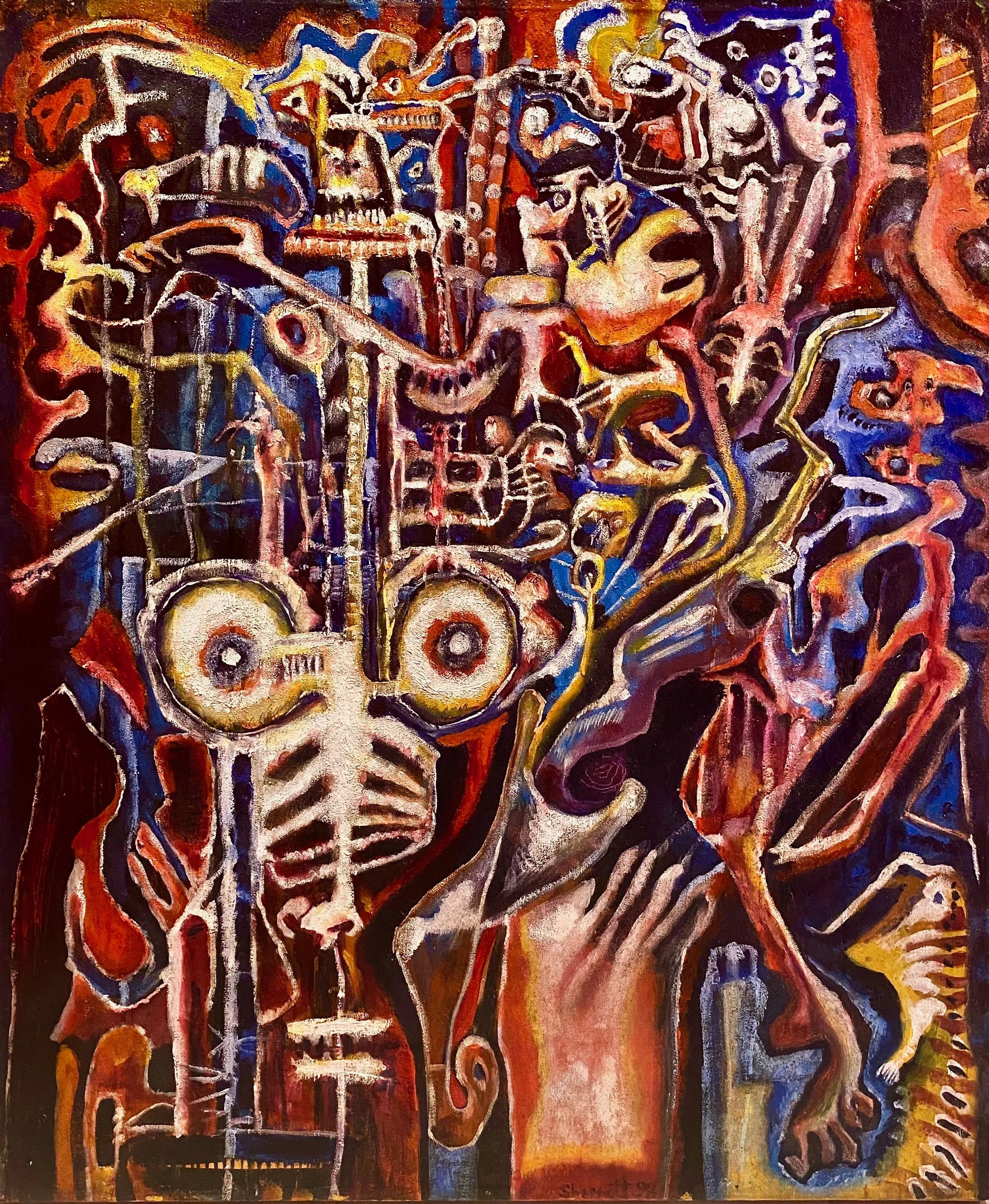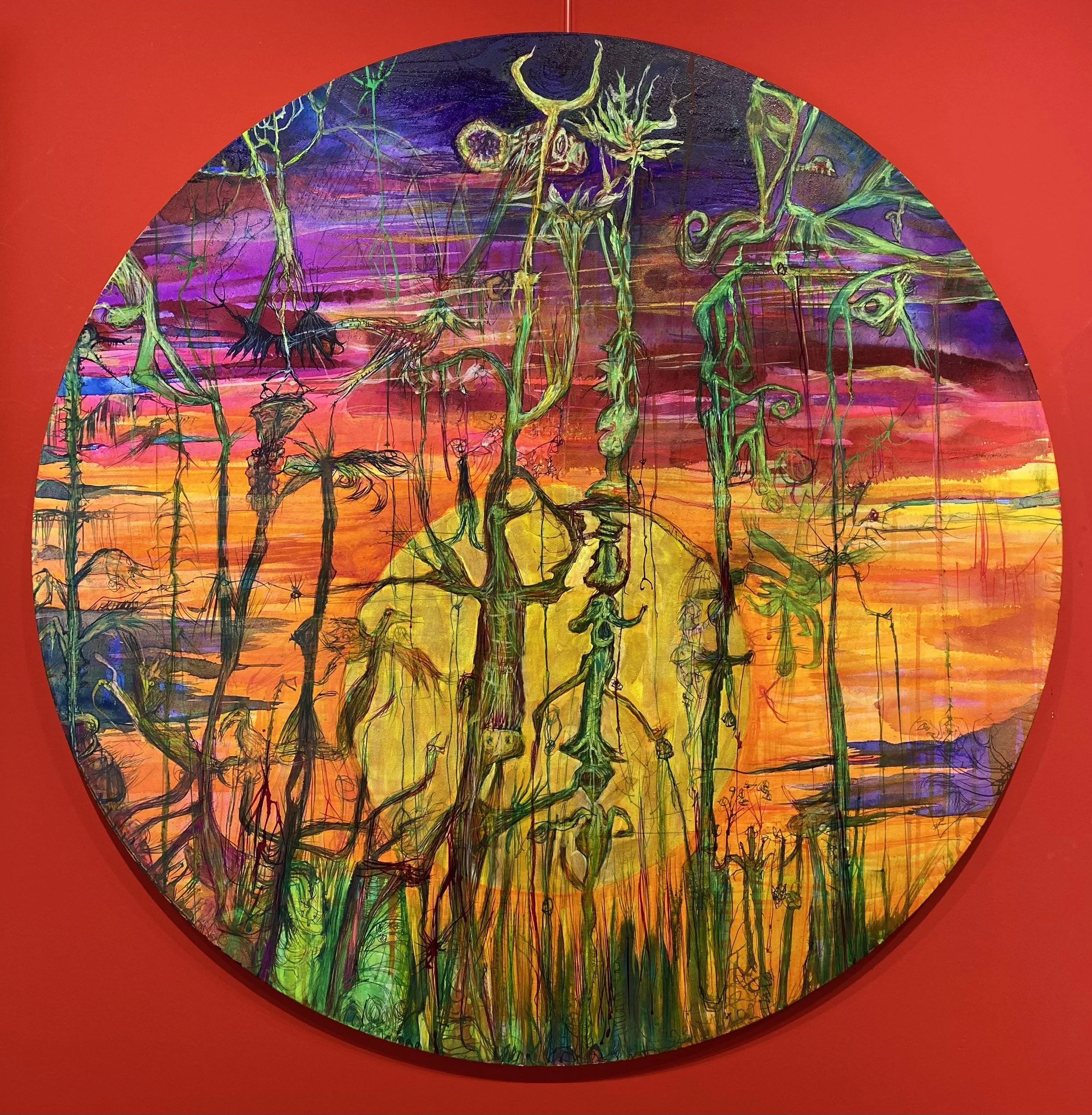LANDMARK PAINTINGS
Title: 'In the Shadow of the Mountain' 1997
Media: Oil on canvas
Size 120 x 90 cm
Location: Private Collection, Melbourne
Title: 'Enchanted Night'
Media: Oil on canvas
Size: 120 x 90 cm
Location: McArthur Collection, Scotland
Title: 'Metamorphosis' , 1970
Media: Oil on canvas
Size: 117 x 94 cm
Location: Private Collection, Lithuania
'The Awakening', 2010
Medium: Oil on canvas
Size: 130 x 250 cm
Location: Giulia Trecenti Tillack Collection, Melbourne
'LIFE', 1998
Medium: Oil on canvas
Size: 100 x 120 cm
Location: Gallery Of Tropical Surrealism , Ubud-Bali, Indonesia.
'Flight Of The Frigate Bird', 2021
Medium: Oil on canvas
Size: 250 x 80 cm
Location: Gallery Of Tropical Surrealism, Ubud-Bali, Indonesia.
When he saw this painting my friend the painter Russell Gregory wrote – “Watery ghosts flipping over the edges of a world of sinew and tissue”.
The paintings are visual poems. Archetypal symbols vie with deep personal references for my attention and perhaps that of the viewer too.
Nowadays I paint outside under the sky in my roof garden and attempt to reconcile such opposites and phenomena as birth, love, sexual reproduction, ageing, death, body and spirit and the limitlessness cosmos.
'Medusa', 2021
Medium: Oil on canvas
Size: 100 x 220 cm
Location: Ubud,Bali, Indonesia.
'The Triptych PANDEMIC', 2020
Medium: Oil on canvas
Size: 250 x 250 cm
Location: The Pottery Museum and Art Gallery, Stoke On Trent, United Kingdom.
This painting was recently acquired by The Museum & Art Gallery of Stoke-on-Trent, UK for the city's permanent collection.
Bruce produced the 3 panels during the first stages of the covid19 pandemic. Inevitably all of the events taking place at that time and still ongoing impacted the painting's evolution and meaning. However the painting became a cathartic expression encapsulating a great many, if not all of the influences that inspired his work over a period of six decades, all the way back to Sherratt's earliest years as a student of art in Stoke-on-Trent and the Staffordshire moorlands where he grew up.
(Note: the gallery is currently closed for a building and expansion programme and the painting will be on public display in the Spring of 2021.
Bruce comments: I did not start painting with the pandemic as my subject.
Painting is a process consisting of a series of skills and techniques. I usually engage in this process in an entirely open-ended way. Sometimes there is some kind of image, technique or feeling that impels or inspires me to embark on the process of improvisation and discovery via certain media and materials. But I neither know nor want to know how it will turn out or what the result will be. All I do know is that I am going to want the final work to be relevant, meaningful, strong and significant in some way and that it should say something.
A virus can be avoided. The atmosphere of the pandemic was and is unavoidable for everyone, including for me, and therefore for my work.
The atmosphere I refer to has nothing to do with passing appearances, superficial impressions or moods. Instead it consists of the entire amalgam of collective, psychological, spiritual, social and political processes, phenomena and events simultaneously taking place. Like air, this kind of atmosphere is filled with various elements. Kandinsky’s words about this are as relevant today as they were in 1912 when he wrote.
Not only visible actions, thoughts and feelings, with outward expression make up this atmosphere, but secret happenings of which no one knows, unspoken thoughts, hidden feelings are also elements in it.(1)
Fear, paranoia, suicide, disease, contagion, guilt, anger, remorse, paradox and perplexity, narrow patriotism or partisanship. There is humanity and inhumanity, cowardice, stupidity, courage, goodness, tyranny, deceit, love, hate, horror stands beside faith, disbelief, torpor and death. There are givers and takers, the overfed, the hungry and the starving. Self-sacrifice mingles with greed, profound generosity stands alongside hypocrisy, tension, uncertainty doubt and delusion, hostility, confusion, insanity, joy in the success and generosity of others, heroism, integrity and justness. There is brilliance, dull-witted foolishness, remorse and conscience.
The impact of fossil fuels in abeyance, air traffic grounded, boarders closed, the physical air and water are cleaner and clearer than before while human thought remains largely hampered, hindered, restricted, opaque and delusional. The proverbial powers that be for the most part continue to sleepwalk. The ‘wise-fool’ on the hill sits stunned while the vulture displays mute power, flight, beauty, freedom, death and the capacity to fly with, over, into and beyond.
Perhaps hope murmurs in the paradox of aesthetic beauty and art, where at least the notion of metamorphosis and rebirth whispers through the improbable harmony of forms and colors.
Is this the music of the spheres that echoes through the mirrors of my ego, even in the midst of decay, and the tune of breathless dismay?
Art is a process, not an absolute, not a noun but a verb. To art involves techniques and skills where the faculties of perception, insight, sensibility, imagination, fantasy, intuition, discernment and feeling are called upon and engaged. These may be called talents, but they can be acquired, developed, extended. They are integrally linked to skills and techniques in the manipulation, control and mastery of media and materials. Take away the instrument and where is the music? Remove the craftsman ship and where is the art?
Kandinsky’s book - Concerning the Spiritual In Art, written in 1912 is one of the most important documents in the history of modern art. Along with his groundbreaking paintings, the book has
had a tremendous impact on the development of modern art.
Kandinsky defines the Inner Need as the quintessence of art. It is built up of three mystical elements. I am mindful of these in all my work, including the triptych PANDEMIC.
1. Every artist, as a creator, has something in him which calls for expression (this is the element of personality).
2. Every artist, as child of his age, is impelled to express the spirit of his age (this is the element of style)- dictated
by the period and particular country to which the artist belongs.
3. Every artist, as a servant of art, has to help the cause of art (this is the element of pure artistry, which is
constant in all ages and among all nationalities).
Kandinsky goes on the say “A full understanding of the first two elements is necessary for a realization of the third. But he who has this realization will recognize that a rudely carved Indian column is an expression of the same spirit as actuates any real work of art today.
Only the third element – that of pure artistry – will remain forever.
'Bali Dawn And The Migration Of Souls', 2024
Medium: Pure Pigments on canvas
Size: dia. 100 cm
Location: Gallery Of Tropical Surrealism, Ubud-Bali, Indonesia.
Rudolf Steiner describes colour as not a static but a dynamic and constantly moving and changing phenomenon. Colour is also a means for the spirit world to manifest and reveal numerous beings, souls and spirits to human sight when the eye is sufficiently sensitive and the imagination free and active enough to perceive them.




